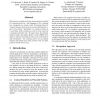Free Online Productivity Tools
i2Speak
i2Symbol
i2OCR
iTex2Img
iWeb2Print
iWeb2Shot
i2Type
iPdf2Split
iPdf2Merge
i2Bopomofo
i2Arabic
i2Style
i2Image
i2PDF
iLatex2Rtf
Sci2ools
PERVASIVE
2004
Springer
2004
Springer
Recognizing Workshop Activity Using Body Worn Microphones and Accelerometers
Most gesture recognition systems analyze gestures intended for communication (e.g. sign language) or for command (e.g. navigation in a virtual world). We attempt instead to recognize gestures made in the course of performing everyday work activities. Specifically, we examine activities in a wood shop, both in isolation as well as in the context of a simulated assembly task. We apply linear discriminant analysis (LDA) and hidden Markov model (HMM) techniques to features derived from body-worn accelerometers and microphones. The resulting system can successfully segment and identify most shop activities with zero false positives and 83.5% accuracy.
Applied Computing | Gestures | Most Gesture Recognition | PERVASIVE 2004 | Systems Analyze Gestures |
| Added | 02 Jul 2010 |
| Updated | 02 Jul 2010 |
| Type | Conference |
| Year | 2004 |
| Where | PERVASIVE |
| Authors | Paul Lukowicz, Jamie A. Ward, Holger Junker, Mathias Stäger, Gerhard Tröster, Amin Atrash, Thad Starner |
Comments (0)

